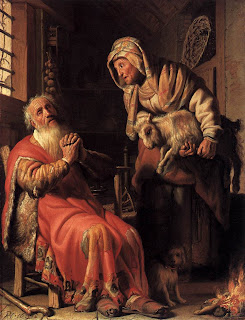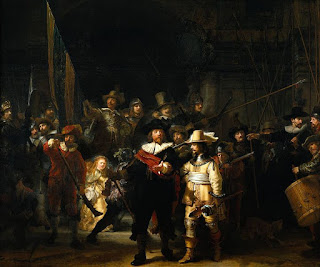The subject of the painting was taken from the
Apocryphal Book of Tobit. Tobit was a wealthy and strict adherent to Mosaic Law.
He lost all of his money and was blinded by an accident. The wife went to work
sewing and washing to support the family. She brought home a kid goat and Tobit
accused her of stealing it. She chastised him for his self-righteousness and
frees him from his limited thinking. Later their fortunes are restored by the
efforts of their son and his eyes fixed from blindness from fish entrails.
The painting helps us think about how even from the
lowest depths man’s lot can change. It is difficult for us to judge others with
any real sense of accuracy. To do so requires the ability to weigh and balance
all of the possible reasons and justifications. Unfortunately, many of us make
the fatal mistake of using self-righteousness to make ourselves look better
than and more moral than others. In this case, freeing himself from his narrow
thinking also freed him to improve his life.
The painting is from Rembrandt and was completed in
Leiden in 1625. He had a knack for putting religious themes and emotion within
his paintings. These emotions related around concepts such as joy and anguish.
As he got older his paintings improved expressing such feelings with ever
increasing finite detail. He turned from a timid painter to a bold painter with
lifelike scenes.
Rembrandt made a mistake in this painting and
covered up an object. He painted over a spinning wheel to express the anguish
and supplication better with Tobit’s hands. The wheel would have shown the rest
of the story and difficulties his wife was having to make ends meet but would
have confused the area. One can still see a part of the spinning wheel and
spokes. Tobit’s is naturally darker in this area.
Rembrandt, known as Rembrandt Harmenszoon van Rijn,
was born in 1606 during the Dutch Golden Age. He is seen as one of the world’s
greatest painters. Even though he achieved success early in his life and his
paintings were popular throughout Europe during his lifetime he had significant
financial hardship in his later years. He liked to buy lots of unique works and
had an extensive collection. Perhaps more than he could afford. Eventually he
needed to liquidate his work through bankruptcy.
One unique feature of Rembrandt was his stereo
blindness. An analysis of a number of paintings helped to determine that his
two eyes did not function together well. He did not perceive the same level of
depth as others. This flattening made it easier for him to draw pictures on a two
dimensional canvas. This became a modern method of teaching art students to
close one eye while painting to create the same effect.
The Reading of Tobit
The Reading of Tobit

